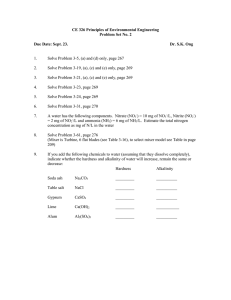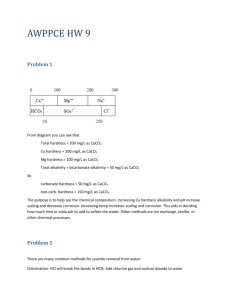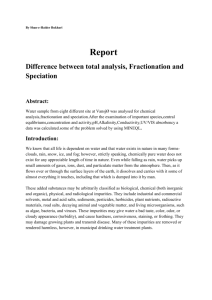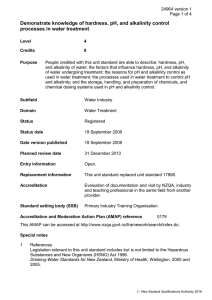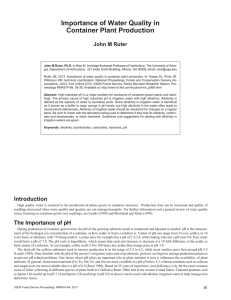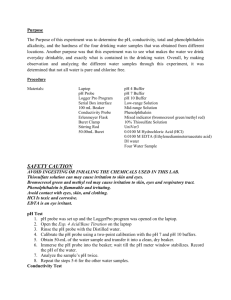Lecture 10 Factors Affecting Water Quality
advertisement
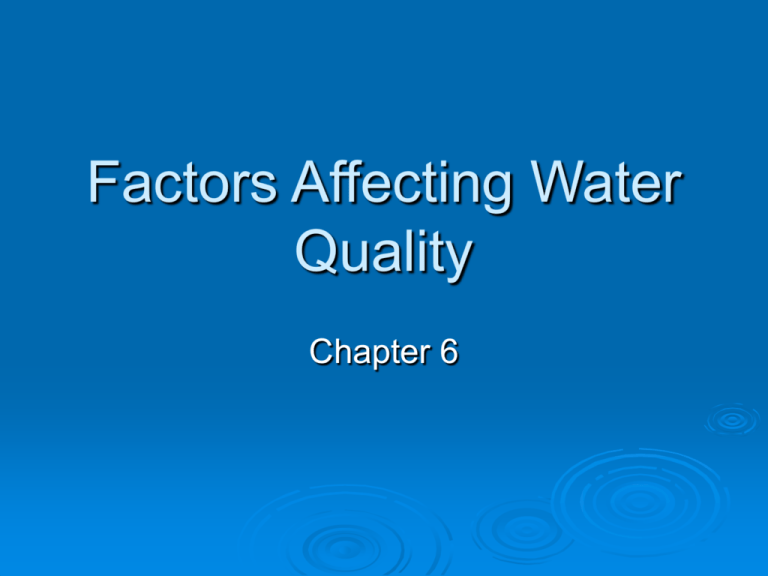
Factors Affecting Water Quality Chapter 6 Introduction Many types of pollutants and many factors affecting the toxic effect of those pollutants Factors include physicochemical properties Mode and time of exposure Environmental factors Interactions among toxicants in a mixture Biological factors Nutritional factors Chemical Characterization of Water I. Structure • Chemical Structure 1. limited in freshwater Inorganic Ca++ Cations Mg++ Na++ (K+) Anions HCO-3 SO4- Cl- PO4- NO3bicarbonate mg/L 15 8 Normal environmental concentrations 6 23 120 12 8 v. low (<1) limited in oceans Note: because NO3- is not limited in freshwater casual about disposal (i.e. Spring River) 2. Organic Carbonate-bicarbonate equilibrium Normal range pH is the master variable but pH of aquatic system is intricately linked to the relative abundance of carbonate, bicarbonate and carbon dioxide. Hardness Degree of difficulty in precipitating soap Based on combined concentrations of calcium, magnesium and other cations Can have great effect of toxicity (increasing hard = decreasing toxicity) Units – CaCO32- mg/L (accounts for all metals which are +2) Typical values (as CaCO32-) • <5- - 100 mg/L soft • 100 - 200 mg/L • >200 “ moderately hard hard Carbonate vs. Non-carbonate hardness Note: heat can change hardness -> forms scale on boilers, coffee pots Alkalinity Measurement of the capacity to accept protons (esp. H+) called buffering capacity Units also expressed as CaCO32Really measures CaCO32- (bicarbonate) Alkalinity directly correlated with hardness in many systems • Soft water = low alkalinity • Hard water = high “ (but exceptions AMD) Measured by titrating with H2SO4 drives bicarbonate to CO2 Rule of thumb water of low hardness, low alkalinity (headwaters) = higher effect of toxicants (especially true of metals, acid) Alkalinity (con’t) Rule of thumb: water of low hardness, low alkalinity (headwaters) = higher effect of toxicants (especially true of metals, acid) Photo by R. Grippo Headwaters of the Hudson River Oxygen Amount of oxygen that can be dissolved in water (solubility) is highly dependent on temperature Note: atmosphere = 210,000 mg/L but ~10 mg/L in most water so O2 is is usually in very short supply in water Physical structure B. Stream order – rough numerical sequence that allows characterization of a stream 1. springs headwaters 1 Note: streams of same order have to come together to form next order 1 2 Mid-reach 2 3 1 3 Lower reach 4 6-12 = river 6 Note: headwaters generally straight, starts to wander (form bends = sinuosity) as hit order 4-6. Sinuosity is a function of slope, hardness of substrate (mud<silt<gravel) Hard substrate = low sinuosity Soft substrate = high sinuosity II. Function - function always based on structure can infer function from structure A. Rivers 1. River Continuum Concept - RCC based on two concepts a. b. From headwaters to mouth = continuous change (gradient) in physical conditions within a stream system Gradient produces a continuous and predictable change in the make-up of the assemblages of organisms within a stream system Upper reaches ---------------- mid-reach --------------------- lower reach (headwater to 3rd order) (order 4 to 6) (>6) Continuous and predictable changes in biotic assemblages Use bioassessment (sample, enumerate organisms) if do not find what is predicted problem!! B. Lakes systems are dynamic but slow Pollution stays put (reason why sewage treatment plants are built on rivers, not lakes More likely to • Serve a pollution sinks (bioremediation slow if lake is deep (e.g. Great Lakes) • Can be highly influenced by aerial deposition C. Groundwater Pollutants usually introduced as leachate from contaminated soils Dependent on physical/chemical properties of soils in addition to water
